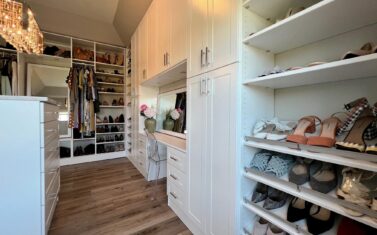
Shelf Versus Drawer Storage When Designing a Custom Closet
3 minute read, by Closet America, on Feb 2, 2017
Shelves? Drawers? Shelves with drawers? Does it matter which option you put in your custom closet? Our designers walk you through the pros and cons of closet shelves and drawers.
I’ve mentioned this many times, but I believe that a balanced closet should contain a mixture of drawers, shelves, and hanging rods to accommodate the complexities of our wardrobes.
But when I’m working with homeowners, a common question that comes up is how much space to devote to each category. We’ve looked at shelves versus hanging rods already, so today I want to tackle the dilemma of deciding between drawer and shelf storage. What’s the difference, and what should you be storing in each space?
Certain Items Work Better on Shelves
Shoes and accessories are always great for shelves, but when it comes to clothing, it can be a little more challenging to determine what to put where. As a rule of thumb, bulky clothing is generally easier to access off shelves for clothes in a closet than in drawers. In particular, consider shelving for:
-
Sweaters. Since sweaters are usually knitted, storing them on shelves helps to prevent any snagging that could occur from putting them into drawers. There are fewer corners for them to catch on.
-
Jeans. Usually, my clients have a variety of styles, washes, and brands, but these differences can be lost if jeans are stored in drawers—it’s too hard to sort through your stacks and find what you need. Shelving makes it much easier to do a quick comparison of your options.
-
Sweats. Like jeans and knits, sweatshirts and sweatpants are thicker items that take up more space than necessary when stored in drawers. Fold these and store on shelves instead. (Just be sure to fold them consistently so your collection doesn’t start to look sloppy.)

All Shelving Should Have a Purpose
If you’re adding shelves in a closet, you also want to make sure that their length and depth match how you’ll actually use them. One of the reasons we take such a thorough inventory of your clothing at the start of the design process is so that we can predict how much space you really need.
Sweaters, for instance, can typically fit in two stacks side by side on a shelf that is thirty inches long. That same shelf length could also hold at least three pairs of women’s or men’s shoes. But if you’ve got a very large sweater collection—or if you never wear them at all—your needs will be a lot different.
The important thing for your closet design is to have a plan for each shelf. Otherwise, they tend to collect household clutter.
Drawers For Closets Are Useful, Too
While open shelves for clothes put your clothing on display, drawers for clothes conceal items, which is absolutely essential for things like underwear and pajamas. There are, however, a few less-obvious clothing categories that tend to work really well in drawers:
-
T-Shirts. While t-shirts can absolutely be stored on wardrobe shelves, trying to pick a shirt from the bottom of the stack without knocking over the rest can be challenging. T-shirts are small and lightweight enough that storing a stack of them in a drawer instead is not only doable—it usually allows you to grab and go more quickly.
-
Belts. I love our sliding belt racks and recommend them every chance I get. If you have an extensive belt collection, though, and especially if you’ve got a lot of novelty belts, storing these in a drawer could make more sense. This lets you roll and categorize your belts by color, style (skinny versus thick), or function (work, fancy, or casual).
-
Leggings. Sometimes I visit homeowners who like to hang leggings in their closets. If you have the hanging space to do this, there’s absolutely nothing wrong with it. But since hanging space is usually prime real estate, I often suggest folding leggings into drawers. Leggings are typically made of durable fabrics that won’t wrinkle easily, so they’ll still be ready to wear.

Ultimately, every wardrobe is different, and the question of whether to store items in drawers or on shelves in a closet doesn’t have to stress you out. It can be a very subjective decision. So take a look at your own clothing collection, keep these tips in mind, and if you find yourself needing more help, you’re welcome to reach out for a free design consultation. We’d love to hear from you!



